Photocatalytic Nanocomposite Polymer-TiO2 Membranes for Pollutant Removal from Wastewater
Abstract
1. Introduction
2. Results and Discussion
2.1. Membrane Morphology
2.2. Membrane Characterization
2.3. Filtration Tests
2.3.1. Impact of Pollutants
2.3.2. Impact of Operating Conditions
2.3.3. Application of Photocatalytic Membranes for Removal of Bacteria from Wastewater
3. Experimental
3.1. Chemicals
3.2. Membrane Fabrication
3.3. Membrane Characterization
3.3.1. Membrane Morphology
3.3.2. Membrane Porosity
3.3.3. Contact Angle
3.3.4. Pure Water Permeability
3.3.5. Permeate Flux and Retention
3.4. Experimental Setup
3.5. Filtration Experiments
3.6. Application of Photocatalytic Membranes for Bacteria Removal from Wastewater
4. Conclusions
Author Contributions
Funding
Conflicts of Interest
References
- Rout, P.R.; Zhang, T.C.; Bhunia, P.; Surampalli, R.Y. Treatment technologies for emerging contaminants in wastewater treatment plants: A review. Sci. Total Environ. 2020, 753, 141990. [Google Scholar] [CrossRef] [PubMed]
- Margot, J.; Rossi, L.; Barry, D.A.; Holliger, C. A review of the fate of micropollutants in wastewater treatment plants. Wiley Interdiscip. Rev. Water 2015, 2, 457–487. [Google Scholar] [CrossRef]
- Rodriguez-Narvaez, O.M.; Peralta-Hernandez, J.M.; Goonetilleke, A.; Bandala, E.R. Treatment technologies for emerging contaminants in water: A review. Chem. Eng. J. 2017, 323, 361–380. [Google Scholar] [CrossRef]
- Deng, Y.; Zhao, R. Advanced oxidation processes (AOPs) in wastewater treatment. Curr. Pollut. Rep. 2015, 1, 167–176. [Google Scholar] [CrossRef]
- Malato, S.; Fernández-Ibáñez, P.; Maldonado, M.I.; Blanco, J.; Gernjak, W. Decontamination and disinfection of water by solar photocatalysis: Recent overview and trends. Catal. Today 2009, 147, 1–59. [Google Scholar] [CrossRef]
- Al-Dawery, S.K. Photo-catalyst degradation of tartrazine compound in wastewater using TiO2 and UV light. J. Eng. Sci. Technol. 2013, 8, 683–691. [Google Scholar]
- da Silva, S.W.; Klauck, C.R.; Siqueira, M.A.; Bernardes, A.M. Degradation of the commercial surfactant nonylphenol ethoxylate by advanced oxidation processes. J. Hazard. Mater. 2015, 282, 241–248. [Google Scholar] [CrossRef]
- Mierzwa, J.C.; Rodrigues, R.; Teixeira, A.C.S.C.; Ameta, I.S.C.; Ameta, R. Advanced Oxidation Processes for Wastewater Treatment: Emerging Green Chemical Technology; Academic Press: Cambridge, MA, USA, 2018; pp. 13–48. [Google Scholar]
- Amor, C.; Marchão, L.; Lucas, M.S.; Peres, J.A. Application of advanced oxidation processes for the treatment of recalcitrant agro-industrial wastewater: A review. Water 2019, 11, 205. [Google Scholar] [CrossRef]
- Fernandes, A.; Makoś, P.; Wang, Z.; Boczkaj, G. Synergistic effect of TiO2 photocatalytic advanced oxidation processes in the treatment of refinery effluents. Chem. Eng. J. 2020, 391, 123488. [Google Scholar] [CrossRef]
- Norman, N.; Anthony, L.; Fane, G.; Ho, W.S.W.; Matsuura, T. Advanced Membrane Technology and Applications; John Wiley & Sons, Inc.: Hoboken, NJ, USA, 2008. [Google Scholar]
- Goh, P.S.; Wong, T.W.; Lim, J.W.; Ismail, A.F.; Hilal, N. Chapter 9-Innovative and sustainable membrane technology for wastewater treatment and desalination application. Innov. Strateg. Environ. Sci. 2020, 291–319. [Google Scholar]
- Khalil, A.M.; Schäfer, A.I. Cross-linked β-cyclodextrin nanofiber composite membrane for steroid hormone micropollutant removal from water. J. Membr. Sci. 2021, 618, 118228. [Google Scholar] [CrossRef]
- Cseri, L.; Topuz, F.; Abdulhamid, M.A.; Alammar, A.; Budd, P.M.; Szekely, G. Electrospun Adsorptive Nanofibrous Membranes from Ion Exchange Polymers to Snare Textile Dyes from Wastewater. Adv. Mater. Technol. 2021, 2000955. [Google Scholar] [CrossRef]
- Ahdab, Y.D.; Rehman, D. Brackish water desalination for greenhouses: Improving groundwater quality for irrigation using monovalent selective electrodialysis reversal. J. Membr. Sci. 2020, 610, 118072. [Google Scholar] [CrossRef]
- Abdulaziz, A.; Sang-Hee, P.; Izwaharyanie, I.; Deepak, A.; Tibor, H.; Ludovic, F.D.; Hong Ngee, L.; Gyorgy, S. Architecting neonicotinoid-scavenging nanocomposite hydrogels for environmental remediation. Appl. Mater. Today 2020, 21, 100878. [Google Scholar]
- Sun, C.; Zhang, N.; Li, F.; Ke, G.; Song, L.; Liu, X.; Liang, S. Quantitative analysis of membrane fouling mechanisms involved in microfiltration of humic acid–protein mixtures at different solution conditions. Water 2018, 10, 1306. [Google Scholar] [CrossRef]
- Galiano, F.; Figoli, A.; Deowan, S.A.; Johnson, D.; Altinkaya, S.A.; Veltri, L.; De Luca, G.; Mancuso, R.; Hilal, N.; Gabriele, B.; et al. A step forward to a more efficient wastewater treatment by membrane surface modification via polymerizable bicontinuous microemulsion. J. Membr. Sci. 2015, 482, 103–114. [Google Scholar] [CrossRef]
- Molinari, R.; Lavorato, C.; Argurio, P. Recent progress of photocatalytic membrane reactors in water treatment and in synthesis of organic compounds. A review. Catal. Today 2017, 281, 144–164. [Google Scholar] [CrossRef]
- Benhabiles, O.; Mahmoudi, H.; Lounici, H.; Goosen, M.F.A. Effectiveness of a photocatalytic organic membrane for solar degradation of methylene blue pollutant. Desalin. Water Treat. 2016, 57, 14067–14076. [Google Scholar] [CrossRef]
- Choi, H.; Stathatos, E.; Dionysiou, D.D. Photocatalytic TiO2 films and membranes for the development of efficient wastewater treatment and reuse systems. Desalination 2007, 202, 199–206. [Google Scholar] [CrossRef]
- Figoli, A.; Ursino, C.; Galiano, F.; Di Nicolò, E.D.; Campanelli, P.; Carnevale, M.C.; Criscuoli, A. Innovative hydrophobic coating of perfluoropolyether (PFPE) on commercial hydrophilic membranes for DCMD application. J. Membr. Sci. 2017, 522, 192–201. [Google Scholar] [CrossRef]
- Hsu, C.H.; Venault, A.; Huang, Y.T.; Wu, B.W.; Chou, C.J.; Ishihara, K.; Chang, Y. Toward antibiofouling PVDF membranes. Langmuir 2019, 35, 6782–6792. [Google Scholar] [CrossRef]
- Romanos, G.E.; Athanasekou, C.P.; Likodimos, V.; Aloupogiannis, P.; Falaras, P. Hybrid Ultrafiltration/Photocatalytic Membranes for Efficient Water Treatment. Ind. Eng. Chem. 2013, 52, 13938–13947. [Google Scholar] [CrossRef]
- Li, X.; Lu, X. Morphology of polyvinylidene fluoride and its blend in thermally induced phase separation process. J. Appl. Polym. Sci. 2006, 101, 2944–2952. [Google Scholar] [CrossRef]
- Gnanou, Y.; Fontanille, M. Organic and Physical Chemistry of Polymers; Wiley Blackwell: Hoboken, NJ, USA, 2008. [Google Scholar]
- Matindi, C.N.; Hu, M.; Kadanyo, S.; Ly, Q.V.; Gumbi, N.N.; Dlamini, D.S.; Li, J.; Hu, Y.; Cui, Z.; Li, J. Tailoring the morphology of polyethersulfone/sulfonated polysulfone ultrafiltration membranes for highly efficient separation of oil-in-water emulsions using TiO2 nanoparticles. J. Membr. Sci. 2021, 620, 118868. [Google Scholar] [CrossRef]
- Yu, J.; Zhang, Y.; Chen, J.; Cui, L.; Jing, W. Solvothermal-induced assembly of 2D-2D rGO-TiO2 nanocomposite for the construction of nanochannel membrane. J. Membr. Sci. 2020, 600, 117870. [Google Scholar] [CrossRef]
- Figoli, A.; Simone, S.; Drioli, E.; Hilal, I.N.; Ismail, A.F.; Wright, C. Membrane Fabrication; Taylor & Francis Group: Boca Raton, FL, USA, 2015; pp. 1–42. [Google Scholar]
- Marino, T.; Blefari, S.; di Nicolò, E.; Figoli, A. A more sustainable membrane preparation using triethyl phosphate as solvent. Green Process. Synth. 2017, 6, 295–300. [Google Scholar] [CrossRef]
- Mozia, S.; Darowna, D.; Przepiórski, J.; Morawski, A.W. Evaluation of performance of hybrid photolysis-DCMD and photocatalysis-DCMD systems utilizing UV-C radiation for removal of diclofenac sodium salt from water. Pol. J. Chem. Technol. 2013, 15, 51–60. [Google Scholar] [CrossRef]
- Said, M.; Nasir, S.; Priadi, D.P. The Effect of Pressure and Time Operation of Gasing River Water Treasure on Pollutant Concentration by Using Ceramic Membrane Separation. Sriwij. J. Environ. 2018, 3, 47–54. [Google Scholar] [CrossRef]
- Marino, T.; Russo, F.; Figoli, A. The Formation of polyvinylidene fluoride membranes with tailored properties via vapour/non-solvent induced phase separation. Membranes 2018, 8, 71. [Google Scholar] [CrossRef] [PubMed]
- Wang, L.; Yong, W.F.; Yu, L.E.; Chung, T. Design of high efficiency PVDF-PEG hollow fibers for air filtration of ultrafine particles. J. Membr. Sci. 2017, 535, 342–349. [Google Scholar] [CrossRef]
- Drelich, J.; Chibowsk, E. Superhydrophilic and superwetting surfaces: Definition and mechanisms of control. Langmuir 2010, 26, 18621–18623. [Google Scholar] [CrossRef]
- de Zárate, J.M.O.; Pen˜a, L.; Mengual, J.I. Characterization of membrane distillation membranes prepared by phase inversion. Desalination 1995, 100, 139–148. [Google Scholar] [CrossRef]
- Kim, Y.C.; Elimelech, M. Adverse impact of feed channel spacers on the performance of pressure retarded osmosis. Environ. Sci. Technol. 2012, 46, 4673–4681. [Google Scholar] [CrossRef]
- Arsuaga, J.M.; Sotto, A.; López-Muñoz, M.J.; Braeken, L. Influence of type and position of functional groups of phenolic compounds on NF/RO performance. J. Membr. Sci. 2011, 372, 380–386. [Google Scholar] [CrossRef]
- Revchuk, A.D.; Suffet, I.N. Ultrafiltration separation of aquatic natural organic matter: Chemical probes for quality assurance. Water Res. 2009, 43, 3685–3692. [Google Scholar] [CrossRef] [PubMed]
- Bandini, S.; Drei, J.; Vezzani, D. The role of pH and concentration on the ion rejection in polyamide nanofiltration membranes. J. Membr. Sci. 2005, 264, 65–74. [Google Scholar] [CrossRef]
- Waeger, F.; Delhaye, T.; Fuchs, W. The use of ceramic microfiltration and ultrafiltration membranes for particle removal from anaerobic digester effluents. Sep. Purif. Technol. 2010, 73, 271–278. [Google Scholar] [CrossRef]
- Molinari, R.; Pirillo, F.; Falco, M.; Loddo, V.; Palmisano, L. Photocatalytic degradation of dyes by using a membrane reactor. Chem. Eng. Process. 2004, 43, 1103–1114. [Google Scholar] [CrossRef]
- Koyuncu, I. Reactive dye removal in dye/salt mixtures by nanofiltration membranes containing vinylsulphone dyes: Effect of feed concentration and cross flow velocity. Desalination 2002, 143, 243–253. [Google Scholar] [CrossRef]
- Qin, J.-J.; Oo, M.H.; Lee, H.; Coniglio, B. Effect of feed pH on permeate pH and ion rejection under acidic conditions in NF process. J. Membr. Sci. 2004, 232, 153–159. [Google Scholar] [CrossRef]
- Benhabiles, O.; Galiano, F.; Marino, T.; Mahmoudi, H.; Lounici, H.; Figoli, A. Preparation and characterization of TiO2-PVDF/PMMA blend membranes using an alternative non-toxic solvent for UF/MF and photocatalytic application. Molecules 2019, 24, 724. [Google Scholar] [CrossRef] [PubMed]
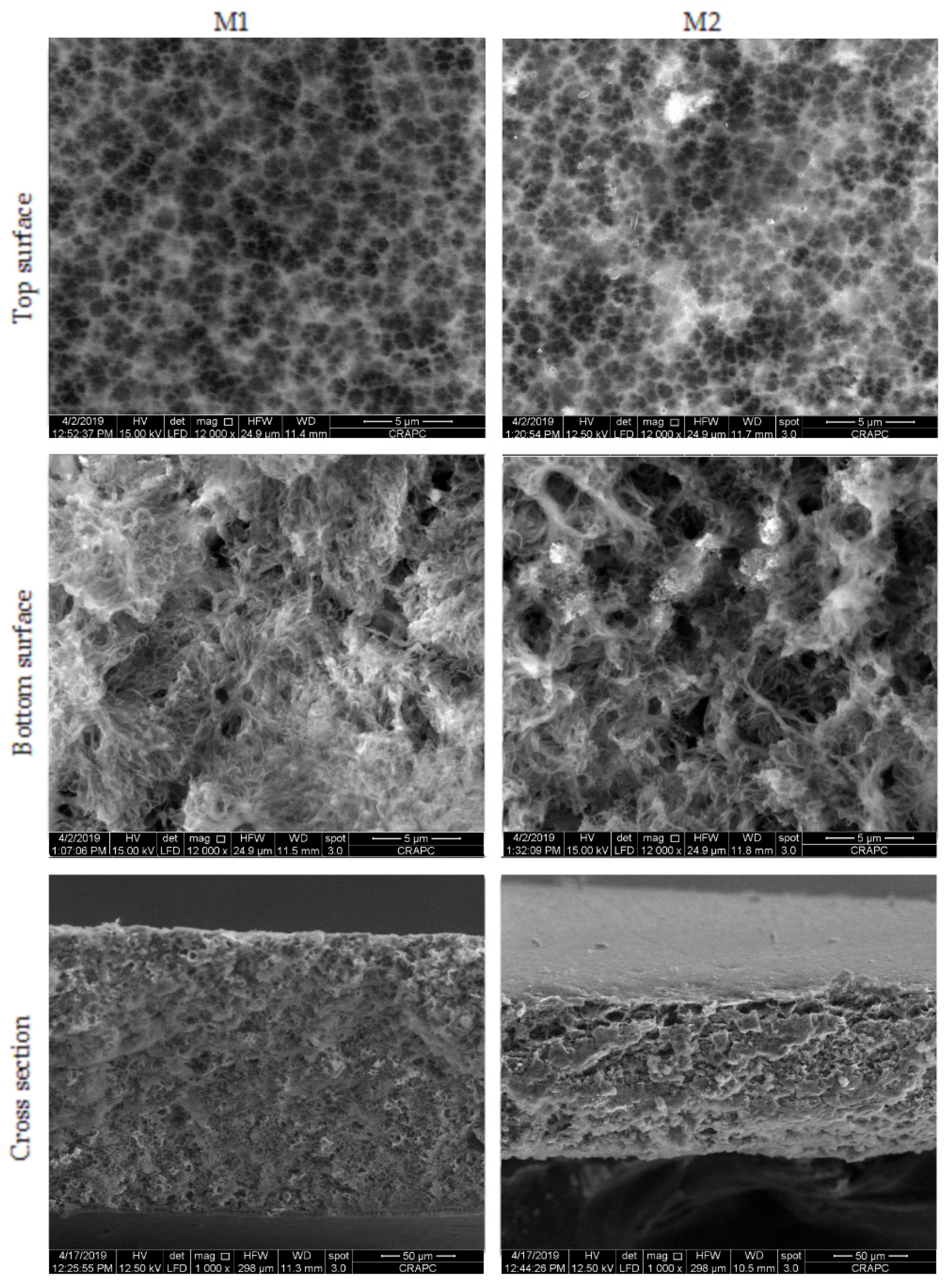
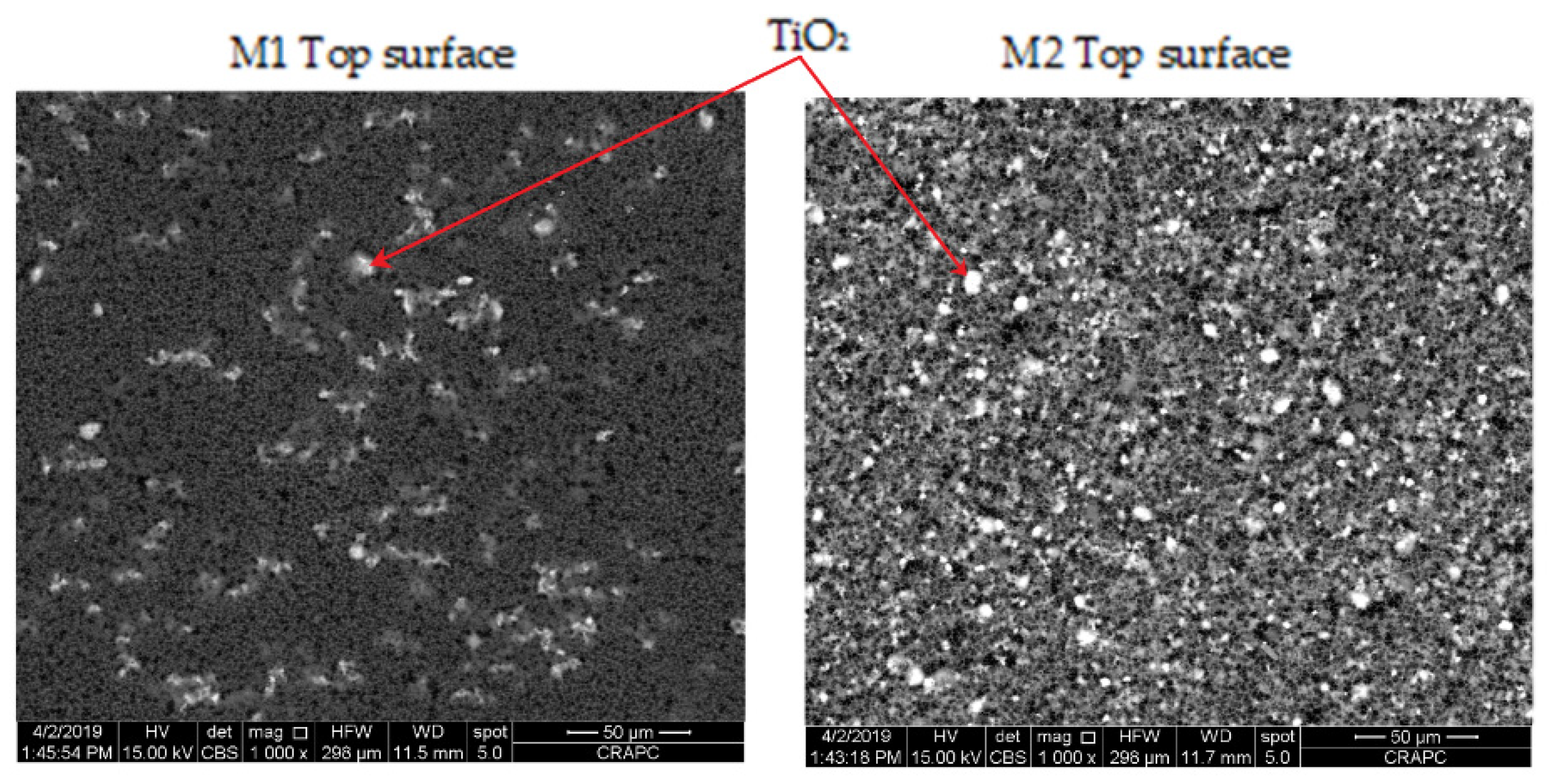
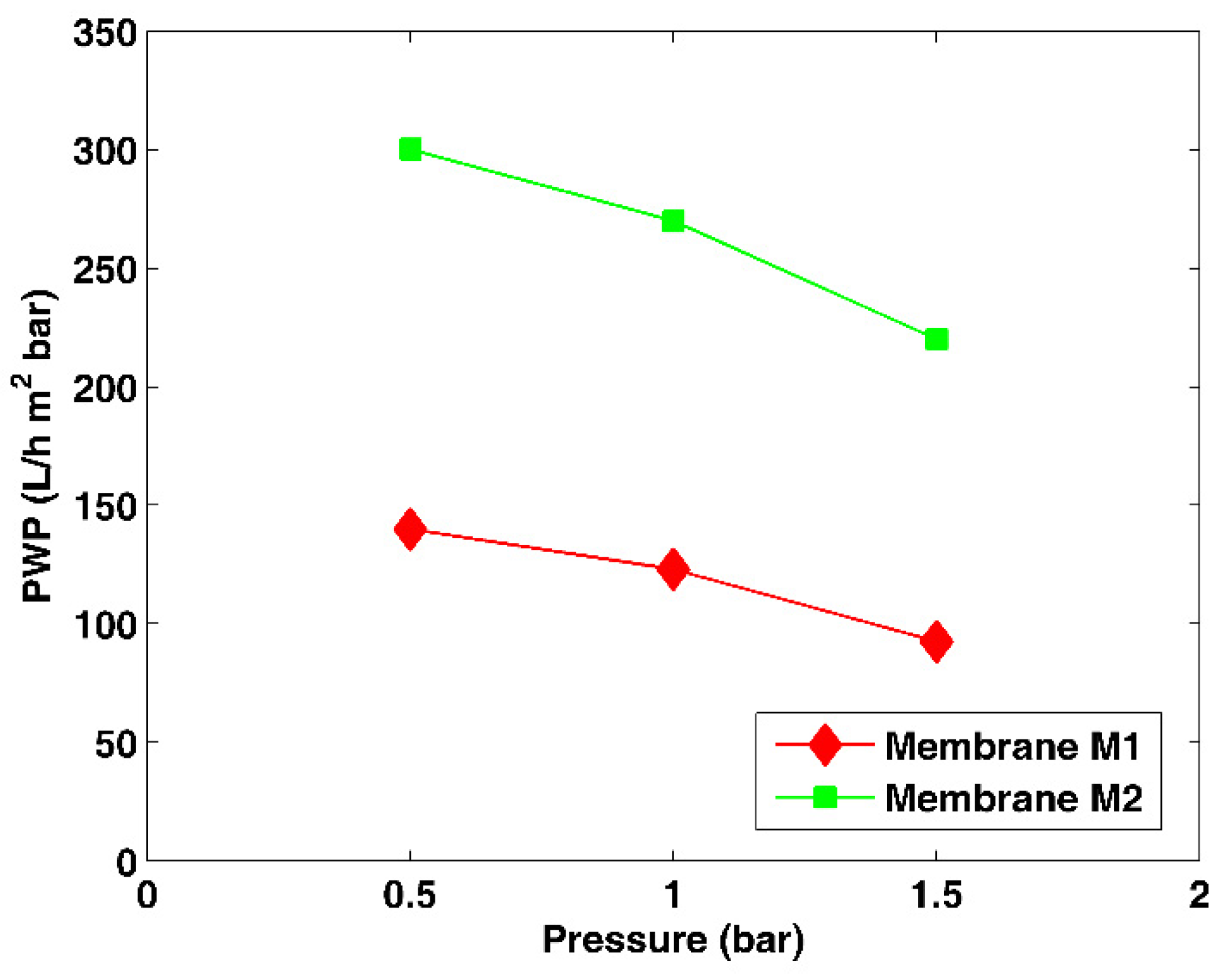

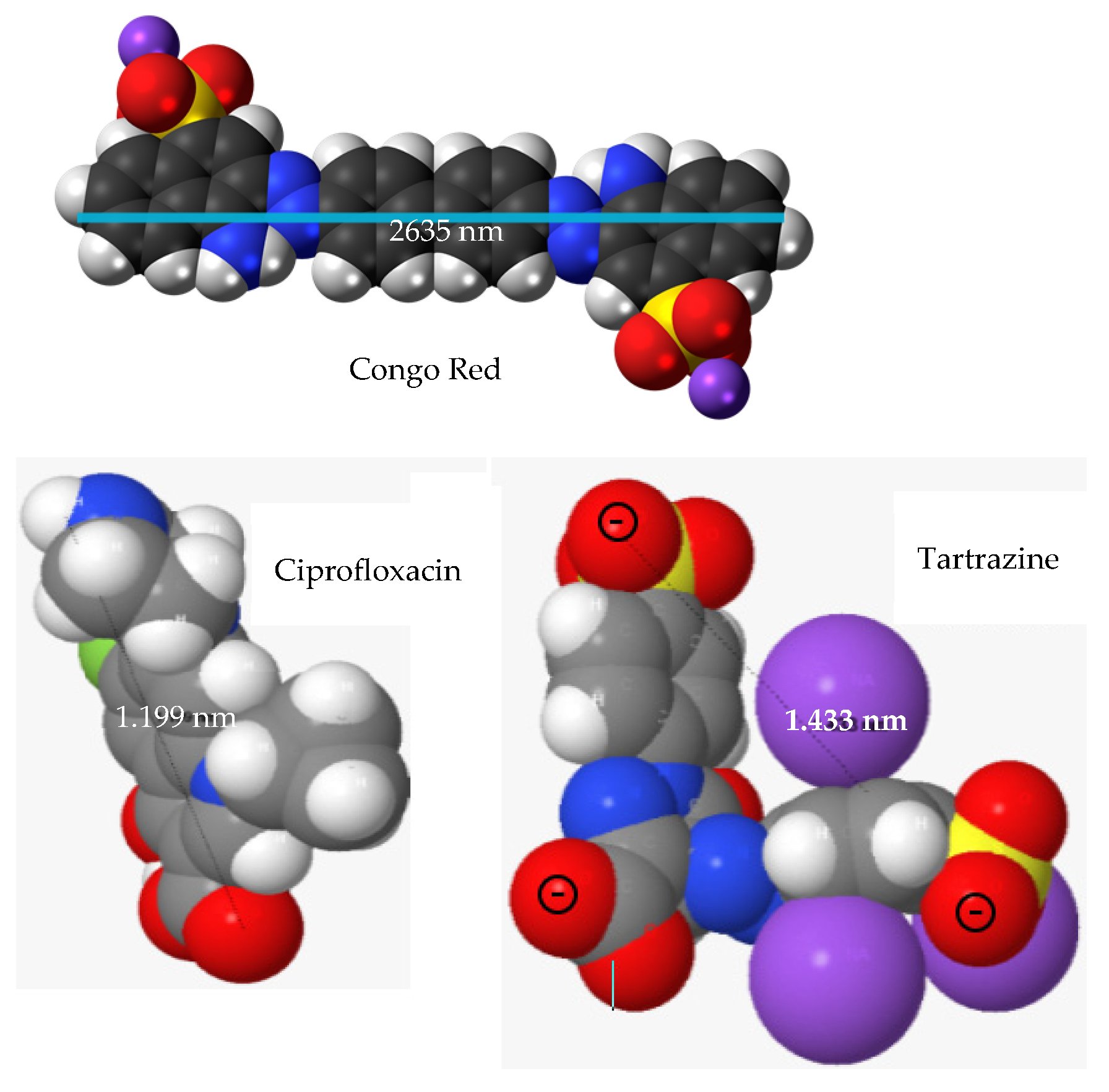
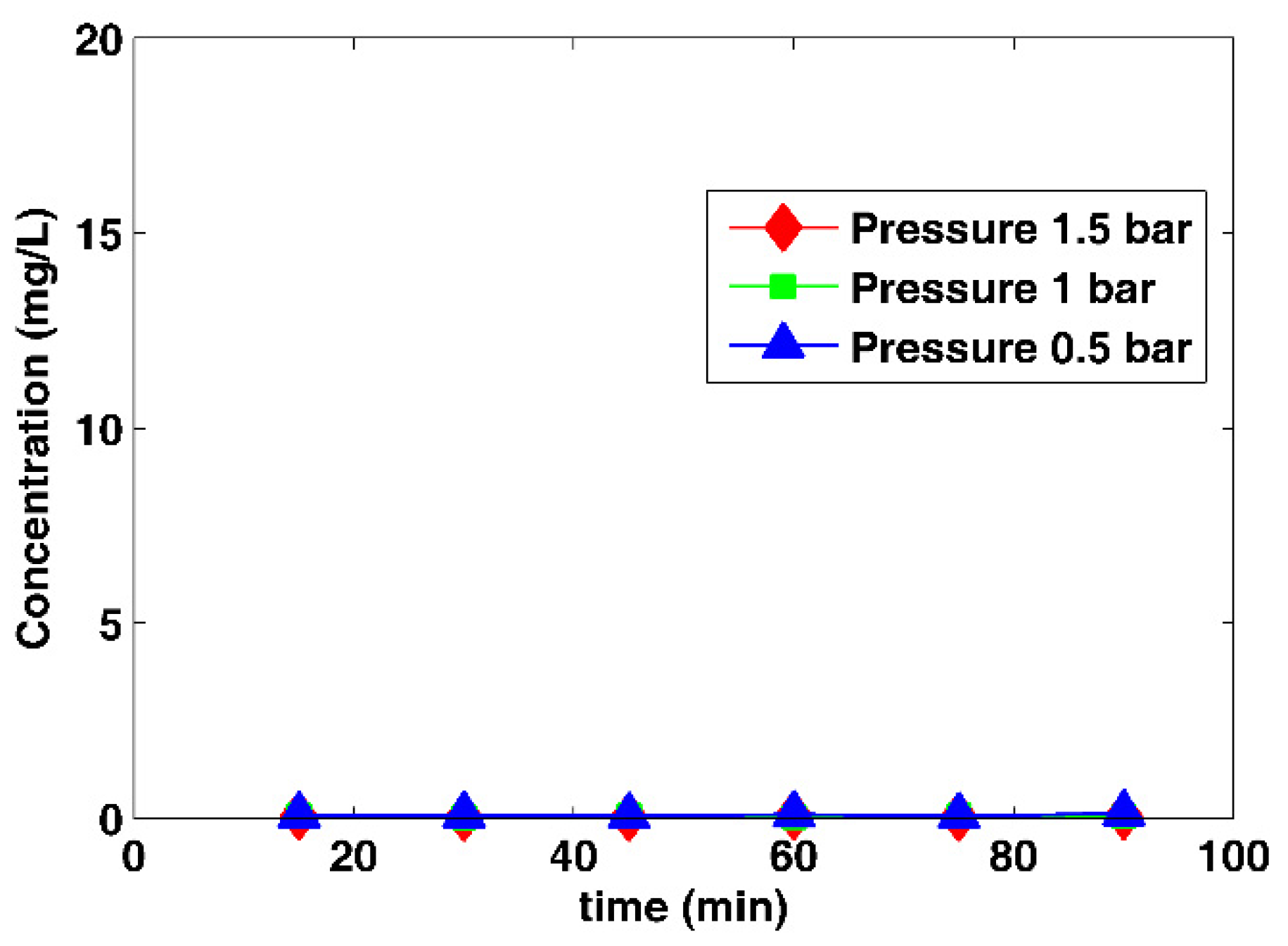
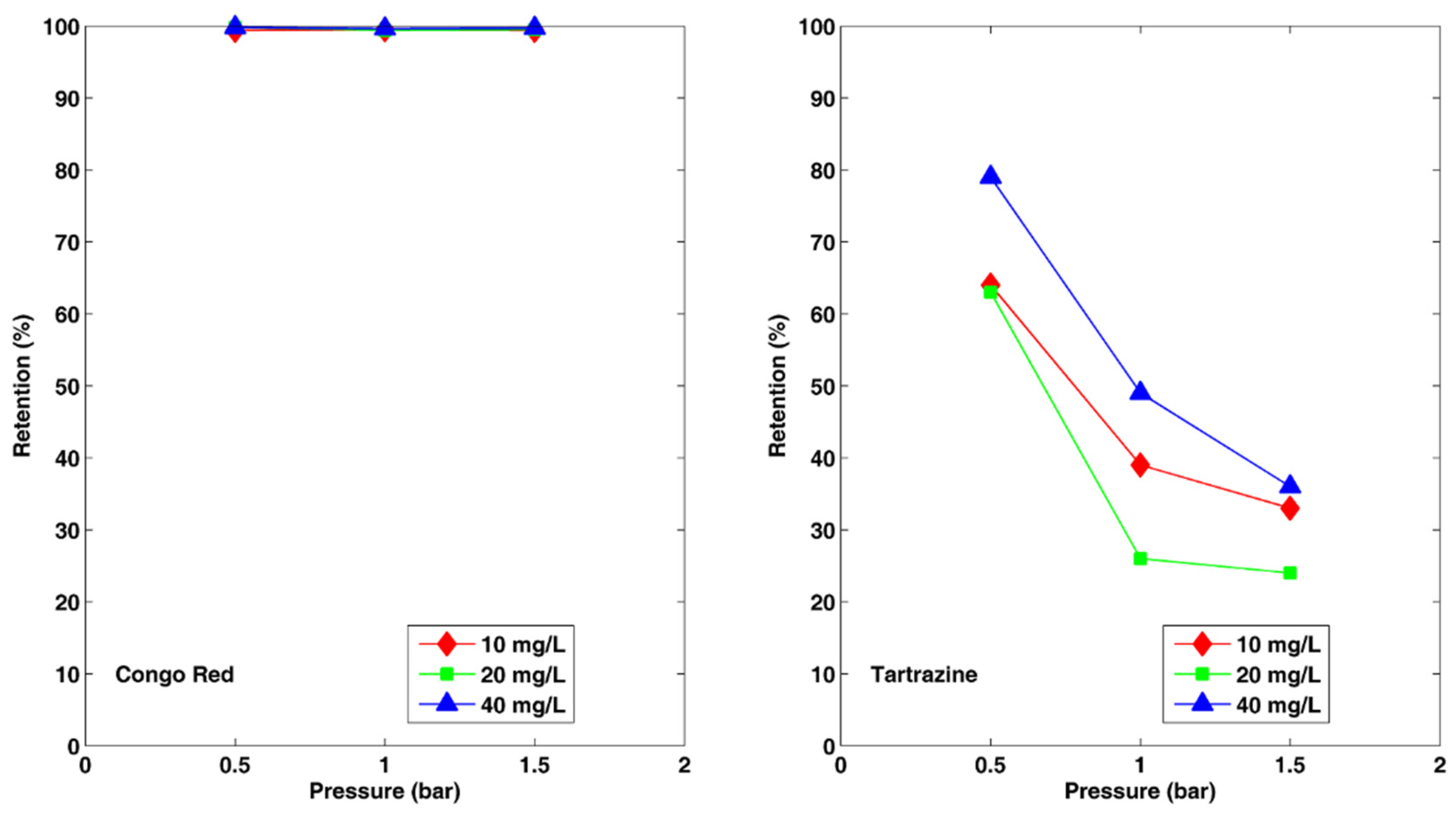
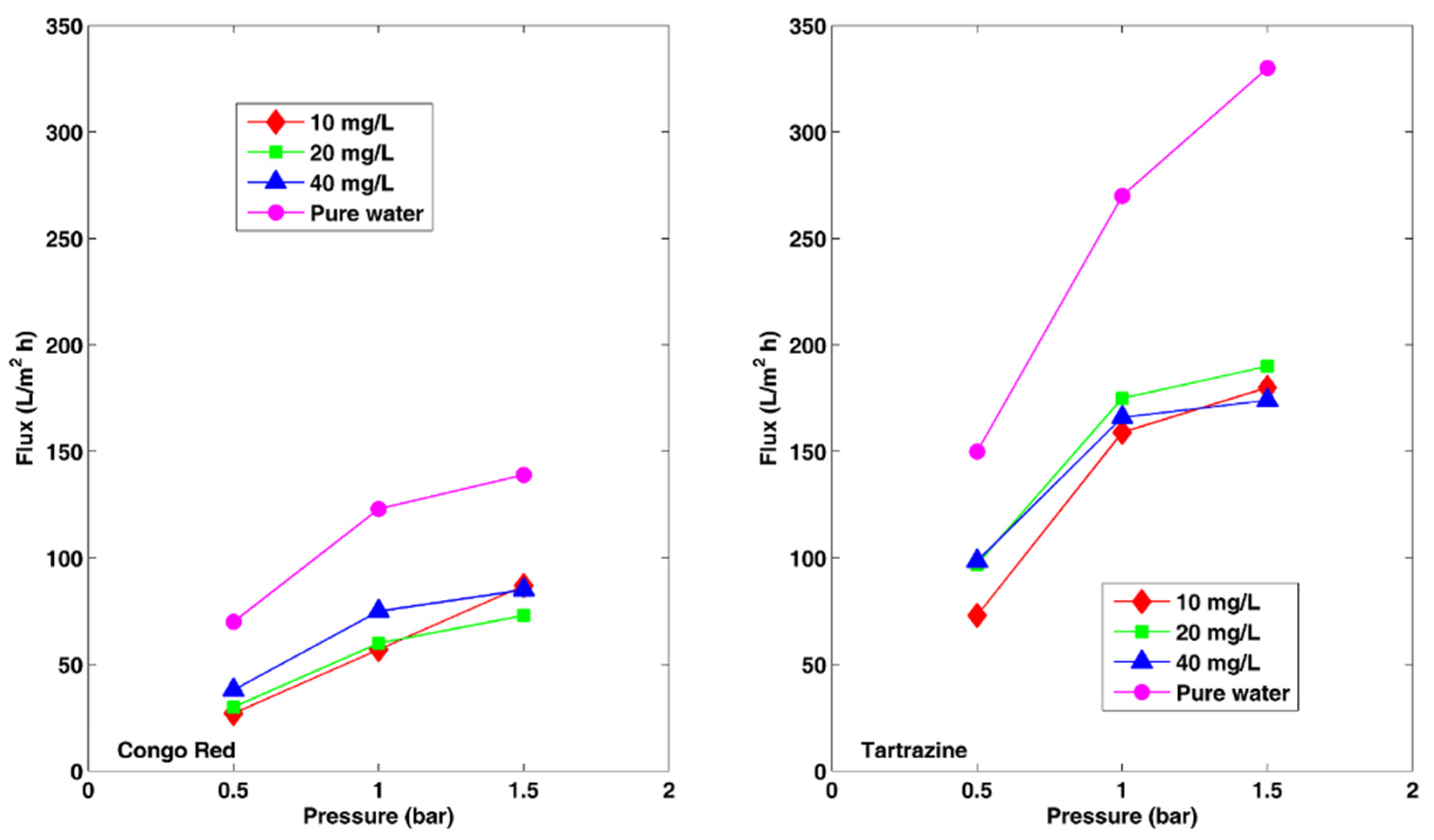

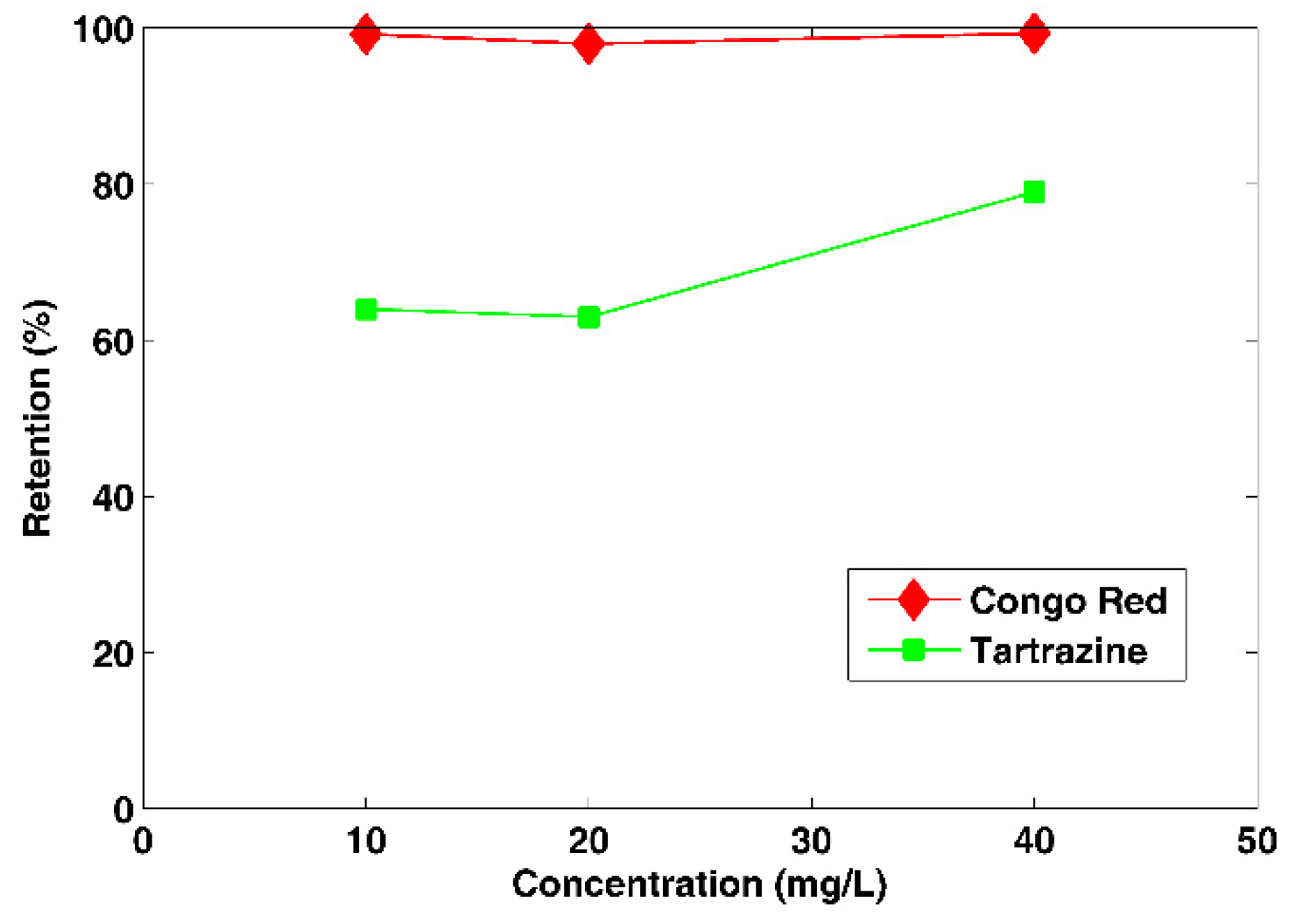
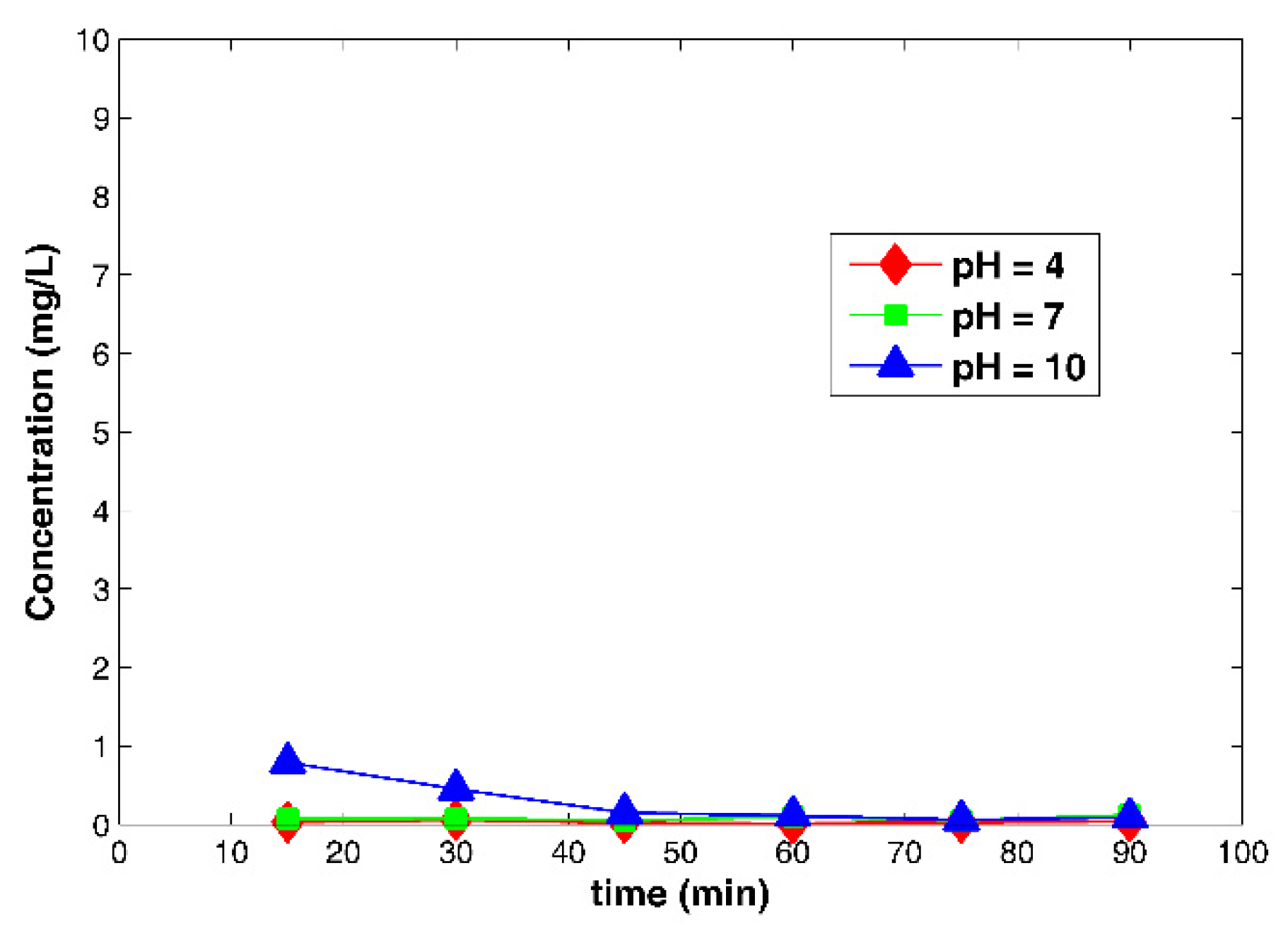
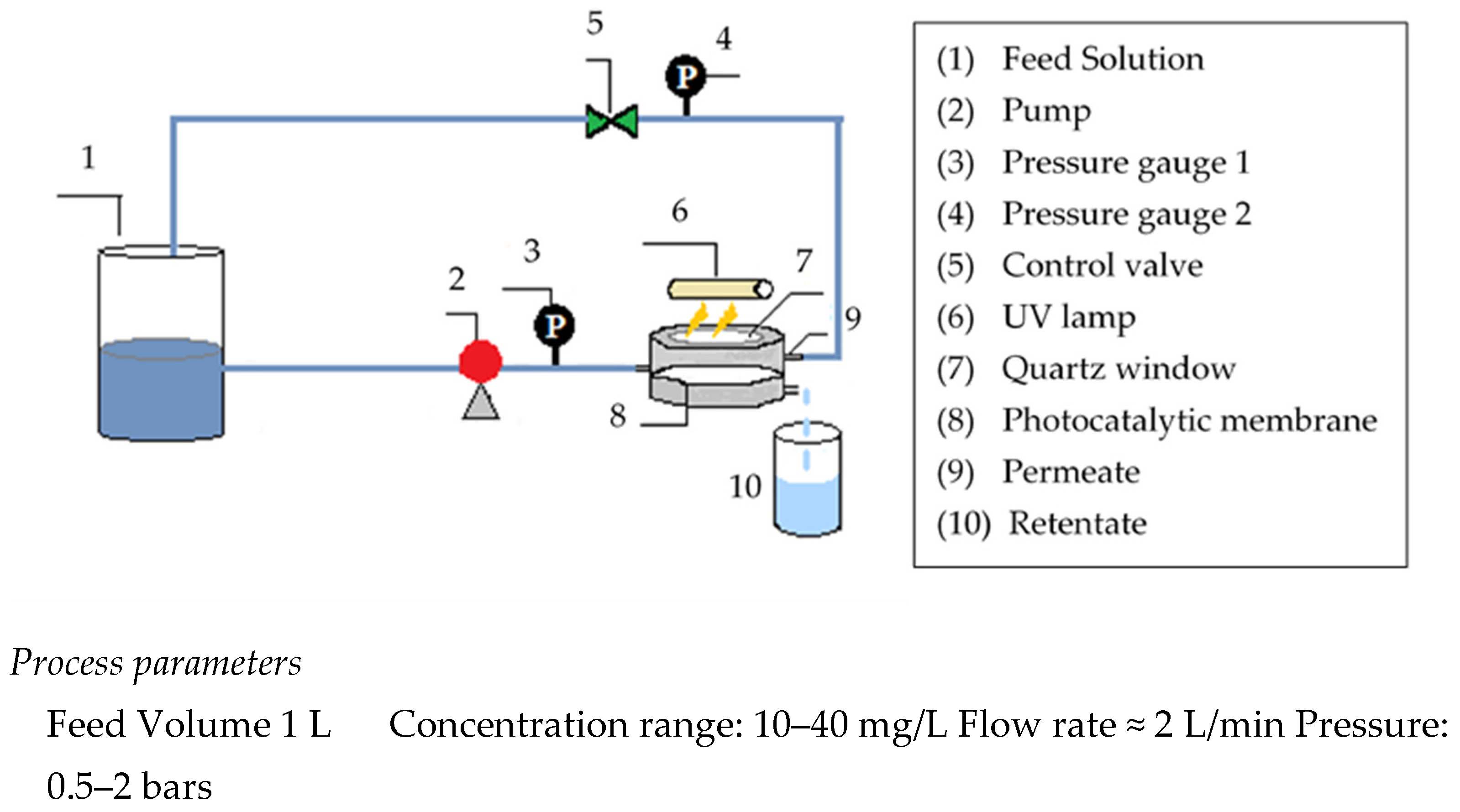
| Membrane | Membrane Thickness | Contact Angle | Pure Water Permeability | Porosity | Pore Size-Average Value |
|---|---|---|---|---|---|
| (mm) | (Degrees) | (L/hm2 bar) | (%) | (nm) | |
| M1 | 0.156 | 90 ± 2.60 | 158 | 36.44 | 150 |
| M2 | 0.099 | 85 ± 2.51 | 226 | 76.76 | 300 |
| Membrane Code | TiO2/wt % | PVDF/wt % | PMMA/wt% | PVP/wt % | PEG/wt % | TEP/wt % |
|---|---|---|---|---|---|---|
| M1 | 2.5% | 7% | 7% | 5% | 5% | 73.5% |
| M2 | 5% | 6% | 6% | 5% | 5% | 73% |
Publisher’s Note: MDPI stays neutral with regard to jurisdictional claims in published maps and institutional affiliations. |
© 2021 by the authors. Licensee MDPI, Basel, Switzerland. This article is an open access article distributed under the terms and conditions of the Creative Commons Attribution (CC BY) license (http://creativecommons.org/licenses/by/4.0/).
Share and Cite
Bouziane Errahmani, K.; Benhabiles, O.; Bellebia, S.; Bengharez, Z.; Goosen, M.; Mahmoudi, H. Photocatalytic Nanocomposite Polymer-TiO2 Membranes for Pollutant Removal from Wastewater. Catalysts 2021, 11, 402. https://doi.org/10.3390/catal11030402
Bouziane Errahmani K, Benhabiles O, Bellebia S, Bengharez Z, Goosen M, Mahmoudi H. Photocatalytic Nanocomposite Polymer-TiO2 Membranes for Pollutant Removal from Wastewater. Catalysts. 2021; 11(3):402. https://doi.org/10.3390/catal11030402
Chicago/Turabian StyleBouziane Errahmani, Khelil, Ouassila Benhabiles, Sohbi Bellebia, Zohra Bengharez, Mattheus Goosen, and Hacene Mahmoudi. 2021. "Photocatalytic Nanocomposite Polymer-TiO2 Membranes for Pollutant Removal from Wastewater" Catalysts 11, no. 3: 402. https://doi.org/10.3390/catal11030402
APA StyleBouziane Errahmani, K., Benhabiles, O., Bellebia, S., Bengharez, Z., Goosen, M., & Mahmoudi, H. (2021). Photocatalytic Nanocomposite Polymer-TiO2 Membranes for Pollutant Removal from Wastewater. Catalysts, 11(3), 402. https://doi.org/10.3390/catal11030402








